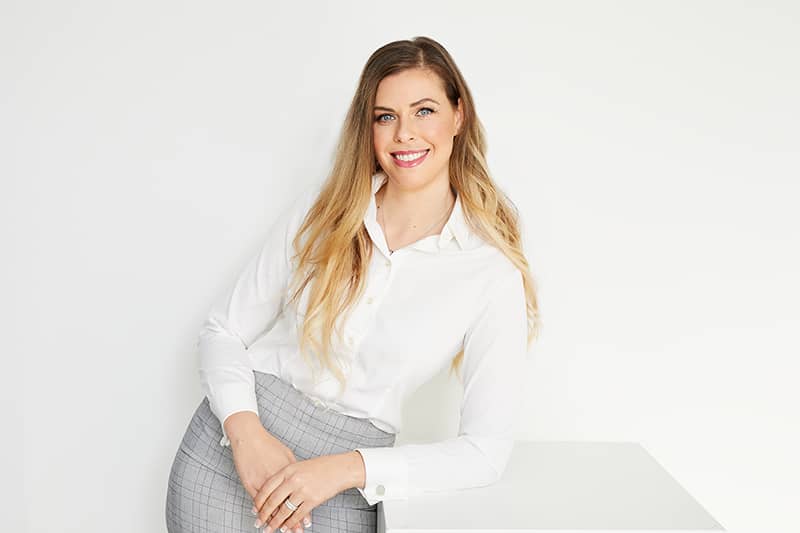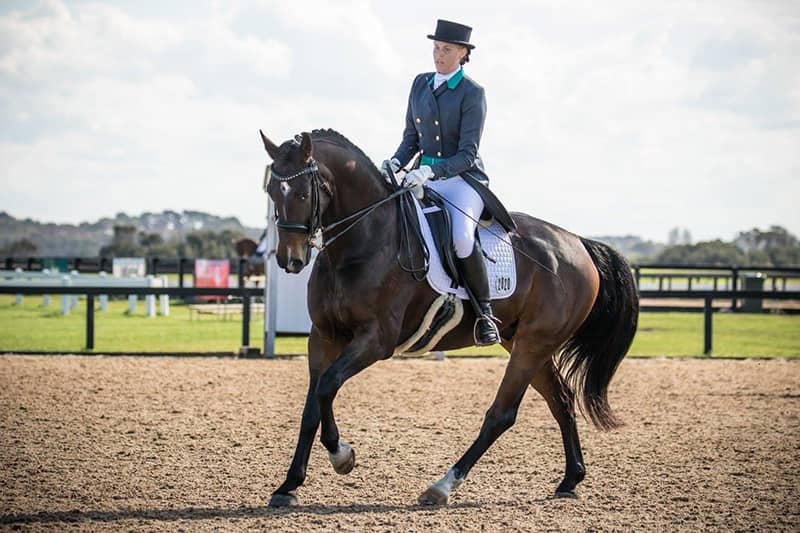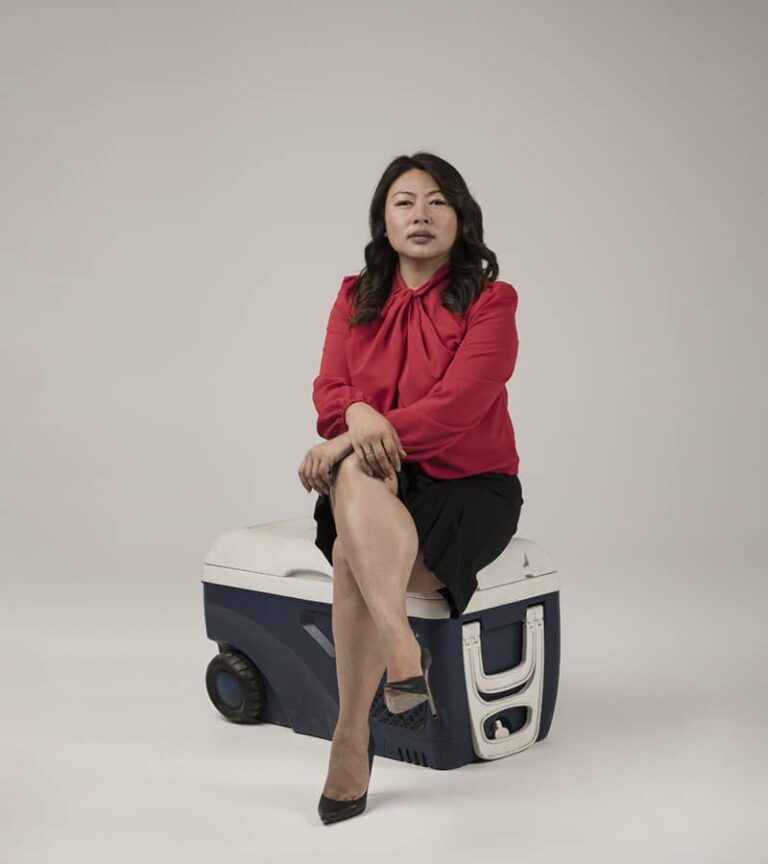I’ve ridden horses my whole life. At age three, I took my first pony ride at a local fair, and then by age seven my parents had bought me my first horse, Honeybabe. When I turned eight, I was competing in and winning equestrian events such as gymkhanas and pony clubs.
In my mid-twenties, I bought my two dressage horses, Riley and CC and I began moving up the ranks, reaching Prix Saint-George, which is the beginning of the international level of dressage. I consequently started my chances for pursuing my ultimate dream of representing Australia at the World Equestrian Games.
In July 2017, I was literally one dressage competition away from qualifying. It was a Thursday night, and the competition was on the weekend, when I was thrown off my saddle during final dressage training and crushed, as the 600kg animal lost her balance and fell on top of me. Knowing that at any moment she would stand up and further trample me, I managed to roll over from underneath her, only to find myself floored with debilitating pain.
Within 10 minutes, paramedics were by my side, asking me if I could wiggle my toes or move my legs. I couldn’t. There was no sensation, and I was positive I’d broken my spine. My life, I realised, had changed irrevocably in that moment.
The long road to recovery
Airlifted to hospital, I underwent a nine-hour surgery to repair my badly broken pelvis, along with numerous fractures in both hips and severe nerve damage to my right leg. I woke to the surgeon saying: “I did the best I could, but it’s not looking good. You will likely be forever reliant on a wheelchair and walking aids.”
Unable to process what was said, I thought I was dreaming. I asked the surgeon to repeat this to me over and over again, before I was able to begin to make sense of his words. Once it sank in and I could no longer live in denial of my new reality, I remember lying in the hospital bed crying non-stop for weeks.
A month later I was transferred to a rehab hospital, to begin learning how to live life in a wheelchair. Within the confines of a hospital room and a wheelchair, my mental and emotional toughness was challenged. I grappled with the overwhelming reality that the dreams I once had would never be realised and that I may spend the rest of my once active and vital life, bound in a chair and if I was lucky, to stand and take a few steps with walking aids. Devastated by this prospect, I fell into a deep depression. That escalated into anxiety and panic attacks. Under the professional care of psychiatrists, I was put on medication, which slowly started to dull the heavy feelings of depression I was carrying.
On a physical level, six days a week I would attend rehabilitation therapy, which included hydrotherapy sessions and occupational therapy, teaching me life skills in a wheelchair.
Feeling that mentally and physically I was taking one step forward and 10 steps backward, to give my life some structure and consistency, I began studying to become a certified public accountant (CPA) from my hospital bed. My psychiatrist also introduced me to positive psychology, and I fell in love with that, leading me also to begin a master’s degree. I also read a lot around how the brain processes pain and empowered with that knowledge, I started to develop strategies to enable me to push through the pain. I became determined to be able to stand and walk again unaided.
Exactly 177 days after my accident, I got the chance to put my skills into practice. I made my first attempt to stand on land. The attempt left me nauseous and reeling from the pain, having only been able to stand without assistance for three seconds. I cried in agony, defeat and frustration at the helplessness of my situation.
But I didn’t give up. As I was allowed to weight bear more and more in the hydrotherapy pool and I started to feel stronger in my legs, I also began to see light at the end of the tunnel. Gradually my fighting spirit revived itself and – spurred on by my newfound reserves of strength – I decided to embrace progress over perfection and break my end goal of walking unaided into incremental goals which I could achieve and celebrate.
In this moment, my mantra of ‘Can do, will do’ was born. And even though it was still an emotional rollercoaster, and the positive emotions didn’t hang around for long, it was still the moment my mindset began to shift.
I started to look forward to waking up the next day, instead of feeling disappointed that I had to face another day. And mentally and emotionally, I realised that I still had a choice: to either let the tragic circumstances dictate the remainder of my life or to face the seemingly impossible goal of walking again with courage, positivity, and spirit. I chose the latter.
During this time the support of my family and friends added to my resolve. My partner, Simon, would come in at dinner time and he would take me to the movies on the weekends. My sister would pick me up and take me to hair and nail appointments and my dad would bring in my dogs, so I could cuddle with them. Everyone would play a role in making me feel connected to my life as it was before.
What wasn’t helpful was people’s negativity. Mostly those who treated me like I was sick or broken and wouldn’t give me enough time to do things at my new pace. Slowly, I filtered those people out of my life.
At the five-month mark, I was able to gain control of my right leg, which had severe nerve damage. Followed by being able to coordinate heel-to-toe action, and then climb stairs, even with aids a month later, it was a promising sign that I would attain my goal of walking unaided.

A new normal
I returned home after six months in hospital, but I attended physio and hydrotherapy daily. My progress continued, and I began to walk around the house without aids. For a distance over 500 metres, I still used crutches or my walking frame. Then, as I neared the two-year mark following my accident, I was able to walk unaided for any distance.
Unfortunately, due to surgeries there were many setbacks. I’ve had problems with my stomach and bladder, my sacroiliac joints have been fused and I’ve had a hip replacement. I’ve had a Dorsal Root Generator (a small device that sends out mild electrical pulses) implanted in my body to help with nerve pain, including a ReActiv8 pulse generator to manage my chronic low back pain.
In total, I’ve endured 25 surgeries in the past six years to rectify the physical damage. As a result, I was back in a wheelchair and using walking aids to recover. This has challenged my resilience because in between I would do all the rehabilitation work to build up strength to be able to walk unaided, and then post-surgery I would have to start all over again.
Despite these setbacks, upon reflection on what was missing in my life, I realised that keeping fit was a big part of my life, so I decided to begin training again.
I discovered the sweet spot between surgeries to build enough fitness to compete in sports, which is also a way for me to deal with stress and helps me to level out my thoughts and emotions.
In 2018 and 2019, I completed 100km bike rides. Currently, I’m training for a 750m swim, a 20km bike ride and a 5km sprint triathlon plus the Amy’s Great Ocean Road Gran Fondo in Victoria, which is a 130km road cycling event to help raise funds for the Amy Gillett Foundation. I hope to achieve that next year, surgeries permitting. When it comes to riding my horses, keeping my feet on the ground is where my mindset is right now. I don’t have plans to begin riding again any time soon.
On the bright side of life, last year I married my partner, Simon, who was very much a key support person in helping me relearn how to walk. It was very emotional and an incredible moment to be able to walk down the aisle and marry him.
As a way to give back and coming from a family of plumbers, I realised there were barriers for women to discover the trades. Thus, in 2020 I started a not-for-profit social enterprise called Empowered Women in Trades, to help women pick up the tools and break gender stereotypes. Last year we had 500 women and non-binary people come through the program and a few of them are now working in the industry. I want to create a culture shift in the space, and I’m focusing on how positive psychology can help create inclusive and safe environments for women – free of bullying and harassment – to thrive and step into management and leadership positions.
Personally, I’ve found peace and have reconciled with the reality of my life – that surgeries are going to be an ongoing part of my life moving forward. I’ve let go of the anger around why this has happened to me, and I’ve actually found a space where I can be grateful for the people I’ve met along the way.
What I would’ve done differently is to have more self-empathy. In the beginning I felt like I was a burden on others and that I wasn’t worth helping. That has transformed into self-compassion, and I’ve realised that my friends and family enjoy supporting me.
If you find yourself in an adverse situation, ask for help. Don’t hold onto shame. Your loved ones don’t see you as worthless, they want to help. Through every challenge and barrier, I’ve discovered that our greatest triumphs often arise from our toughest trials. Let’s embrace each obstacle as a stepping.
How to achieve post-traumatic growth
Post-traumatic growth occurs when a person experiences significant positive character and life changes from successfully overcoming mental, emotional or physical challenges in their life. The growth comes from discovering how rewarding it can be to live outside your comfort zone and expand previously held perceptions or understandings about life.
“Acceptance of the things you cannot change or control, including gaining awareness of the root cause of your trauma, can help the brain process trauma faster, are both key to moving forward after trauma to begin to heal,” says New Zealand-based Rhonda van de Geest, Somatic Trauma Informed Coach, at Victory Overwhelming. “When you decide to focus on overcoming the challenges you can exert control over, you step onto the first rung of the post-traumatic growth ladder, which becomes easier as you strengthen your ‘resilience muscle’,” says Van de Geest.
Van de Geest adds that moderate trauma can be released emotionally from the body by partaking in activities that allow you to feel entirely present in the moment, such as physical movement in the form of yoga, dancing, theatre or deep breathing.
It’s also important not to persevere through trauma alone. Mentors or coaches who have ‘lived experience’ of overcoming similar trauma, or support groups, can help you to thrive post trauma.
“Family and friends can equally support you as you persevere through the discomfort of overcoming your challenges, by providing a wider or clearer perspective of the next best step towards post-trauma growth,” says Van de Geest. “Post-trauma growth may occur as you start to recognise your innate strengths and spiritual gifts, leading to a new life purpose.”
Core benefits of post-traumatic growth include:
• Greater awareness of the value and importance of healthy relationships;
• Increased awareness of what’s important in life;
• New awareness of personal strengths;
• Newfound levels of confidence, calm, creativity, joy, faith, connectedness and compassion;
• Improved resilience, mental, emotional and spiritual health.
For help with PTSD, visit:
healthify.nz; mentalhealth.org.nz; beyondblue.com.au







